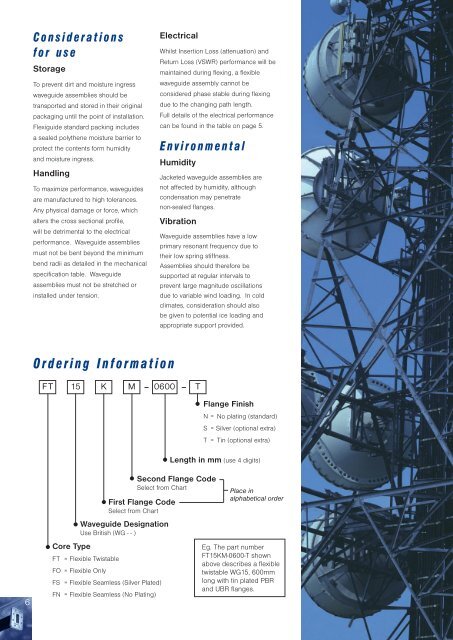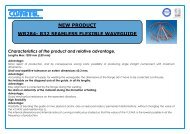Flexiguide Brochure - Arva-RF
Flexiguide Brochure - Arva-RF
Flexiguide Brochure - Arva-RF
You also want an ePaper? Increase the reach of your titles
YUMPU automatically turns print PDFs into web optimized ePapers that Google loves.
6<br />
Considerations<br />
for use<br />
Storage<br />
To prevent dirt and moisture ingress<br />
waveguide assemblies should be<br />
transported and stored in their original<br />
packaging until the point of installation.<br />
<strong>Flexiguide</strong> standard packing includes<br />
a sealed polythene moisture barrier to<br />
protect the contents form humidity<br />
and moisture ingress.<br />
Handling<br />
To maximize performance, waveguides<br />
are manufactured to high tolerances.<br />
Any physical damage or force, which<br />
alters the cross sectional profile,<br />
will be detrimental to the electrical<br />
performance. Waveguide assemblies<br />
must not be bent beyond the minimum<br />
bend radii as detailed in the mechanical<br />
specification table. Waveguide<br />
assemblies must not be stretched or<br />
installed under tension.<br />
Ordering Information<br />
Electrical<br />
Whilst Insertion Loss (attenuation) and<br />
Return Loss (VSWR) performance will be<br />
maintained during flexing, a flexible<br />
waveguide assembly cannot be<br />
considered phase stable during flexing<br />
due to the changing path length.<br />
Full details of the electrical performance<br />
can be found in the table on page 5.<br />
Environmental<br />
Humidity<br />
Jacketed waveguide assemblies are<br />
not affected by humidity, although<br />
condensation may penetrate<br />
non-sealed flanges.<br />
Vibration<br />
FT 15 K M 0600 T<br />
Waveguide assemblies have a low<br />
primary resonant frequency due to<br />
their low spring stiffness.<br />
Assemblies should therefore be<br />
supported at regular intervals to<br />
prevent large magnitude oscillations<br />
due to variable wind loading. In cold<br />
climates, consideration should also<br />
be given to potential ice loading and<br />
appropriate support provided.<br />
Flange Finish<br />
N = No plating (standard)<br />
S = Silver (optional extra)<br />
T = Tin (optional extra)<br />
Length in mm (use 4 digits)<br />
Second Flange Code<br />
Select from Chart<br />
First Flange Code<br />
Select from Chart<br />
Waveguide Designation<br />
Use British (WG - - )<br />
Core Type<br />
FT = Flexible Twistable<br />
FO = Flexible Only<br />
FS = Flexible Seamless (Silver Plated)<br />
FN = Flexible Seamless (No Plating)<br />
Place in<br />
alphabetical order<br />
Eg. The part number<br />
FT15KM-0600-T shown<br />
above describes a flexible<br />
twistable WG15, 600mm<br />
long with tin plated PBR<br />
and UBR flanges.



